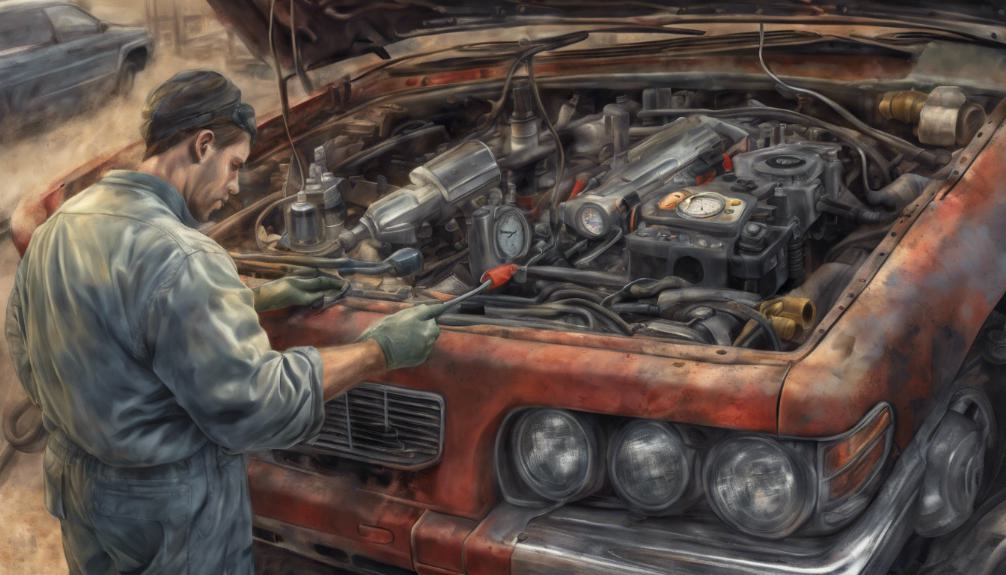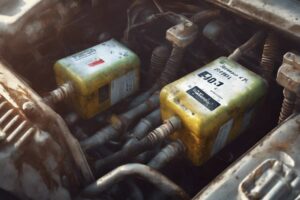If you’re facing a P0089 code indicating fuel pressure regulator issues, check the low-pressure side fuel pressure sensor G410 and fuel pump control module J538.
Use an OBD-II scanner for confirmation and conduct pressure tests to identify irregularities. Inspect for leaks and damage, focusing on the fuel pressure sensor.
Promptly replace any faulty components to resolve the problem effectively. Further details on diagnosing and addressing this issue can provide insight into resolving it efficiently.
Key Points
- Use OBD-II scanner for performance confirmation.
- Conduct thorough pressure testing.
- Inspect for leaks or damages.
- Check fuel pressure sensor functionality.
- Promptly replace faulty components.
P0089 Code Overview

If you’re experiencing a P0089 code, it signals potential fuel pressure regulator performance issues that require immediate attention. Pressure sensor troubleshooting is vital in diagnosing the problem.
Issues with the low-pressure side fuel pressure sensor G410 or the fuel pump control module J538 are common culprits. To pinpoint the exact cause, fuel pump diagnostics are essential.
Manual fuel pressure checks can aid in this diagnostic process. For accurate tests, using factory VW tools or professional scanners is necessary.
To guarantee accurate readings, proper equipment and procedures must be followed. If you encounter difficulties running Basic Setting 103, it may require continuous driving for 0.5 hours to resolve.
By carefully examining the pressure sensor and conducting thorough fuel pump diagnostics, you can identify the root cause of the P0089 code. Addressing these issues promptly can prevent further damage to your vehicle’s fuel system.
Symptoms and Indications
Symptoms and indications of fuel pressure regulator performance issues may manifest through various noticeable signs in your vehicle.
When facing a P0089 code, your check engine light might illuminate, signaling a potential problem with the fuel pressure regulator.
Poor acceleration and misfires could also be experienced, affecting your engine’s performance.
Reduced fuel efficiency and engine stalling are additional indicators that the fuel pressure regulator may not be functioning correctly.
It’s important to address these symptoms promptly as ignoring the P0089 code can lead to serious driveability issues and risks while driving.
Whats more, multiple other codes appearing alongside P0089 could point to broader fuel system complications.
To pinpoint the exact cause, fuel pressure diagnostics should be conducted to assess the regulator’s performance accurately.
If you notice any of these symptoms, it’s advisable to seek professional assistance to diagnose and rectify any underlying engine performance issues promptly.
Common Causes Identified

When diagnosing fuel pressure regulator performance issues, common causes identified often revolve around components such as the low-pressure side fuel pressure sensor G410 or the fuel pump control module J538.
To effectively address fuel pressure diagnosis problems and conduct fuel system troubleshooting, consider the following:
- Low-pressure side fuel pressure sensor G410: This sensor plays an essential role in monitoring fuel pressure and can be a common culprit for fuel pressure irregularities.
- Fuel pump control module J538: Issues with this module can directly impact the fuel pump’s operation, leading to fuel pressure regulation issues.
- Faulty fuel pump: A malfunctioning fuel pump can result in inadequate fuel delivery, affecting fuel pressure regulation and triggering performance problems.
- Clogged fuel filter: A clogged filter can restrict fuel flow, causing pressure fluctuations and potentially triggering the P0089 code.
Diagnosing the Fuel Pressure Regulator
To properly diagnose the fuel pressure regulator, start by confirming its performance using an OBD-II scanner.
This tool will help you retrieve any error codes related to the fuel system, providing valuable insights into potential issues.
Next, conduct a pressure testing to make sure the fuel pressure levels are within the recommended range. Any deviations from the specified values could indicate a problem with the regulator.
During this process, perform a thorough inspection of the regulator for any signs of leaks, damage, or malfunctions. It’s important to check for these issues as they can impact the overall performance of the fuel system.
Then, pay close attention to the fuel pressure sensor, ensuring it’s providing accurate readings and functioning correctly.
If you identify any faults with the fuel pressure regulator or sensor, replacing them promptly is necessary to address any performance issues effectively.
Can a Stuck Open Throttle Actuator Cause Fuel Pressure Regulator Performance Issues?
Yes, a stuck open throttle actuator can cause fuel pressure regulator performance issues. It can disrupt the engine’s fuel flow and lead to irregular fuel pressure. To solve this, consult a professional for a throttle actuator control system fix to ensure proper fuel pressure regulation.
Resolving P0089 Code Issues

If you’re facing a P0089 code, addressing the underlying fuel pressure regulator performance issue is crucial. To resolve P0089 code issues related to the fuel system and performance analysis, consider the following steps:
- Check Fuel Pressure Regulator: Verify if the fuel pressure regulator is operating correctly to guarantee proper fuel pressure regulation.
- Inspect Fuel Filter: Examine the fuel filter for any clogs or blockages that could impede fuel flow to the engine.
- Evaluate Fuel Pump: Test the fuel pump to determine if it’s delivering fuel at the required pressure for top-notch engine performance.
- Review Fuel System Components: Assess all fuel system components, including sensors, for any potential faults affecting fuel delivery and pressure regulation.
Preventive Maintenance Tips
Conduct regular fuel system maintenance to guarantee peak performance and longevity of your vehicle. Start by regularly checking and replacing fuel filters to maintain proper fuel flow and prevent clogs.
Using high-quality fuel is essential to reduce the risk of deposits and contaminants affecting the fuel pressure regulator.
Inspect fuel lines and connections for leaks or blockages that can impact fuel pressure regulation. Follow the manufacturer’s recommended maintenance schedule to ensure top-notch performance of the fuel system.
Consider professional fuel system cleaning services to remove buildup and improve fuel pressure regulation.
As an Amazon Associate we earn from qualifying purchases.










